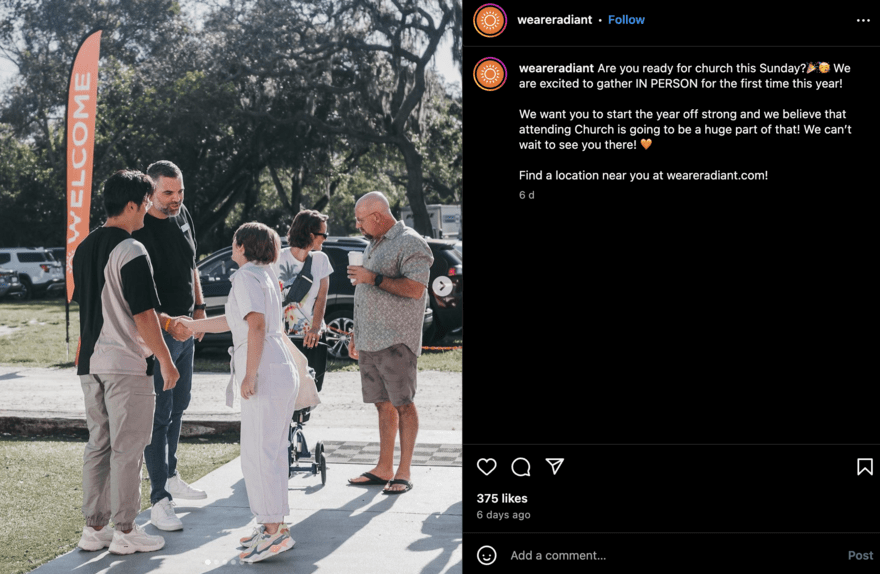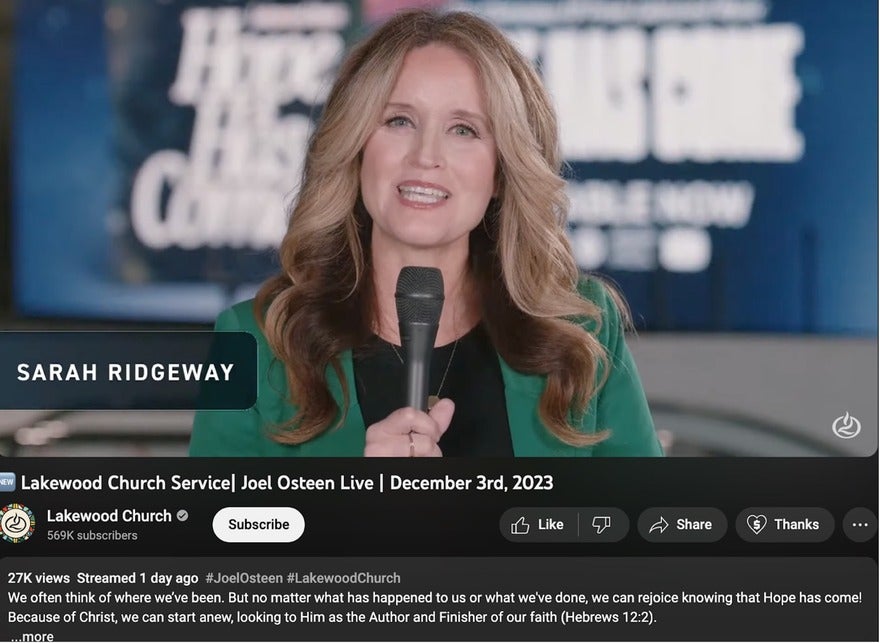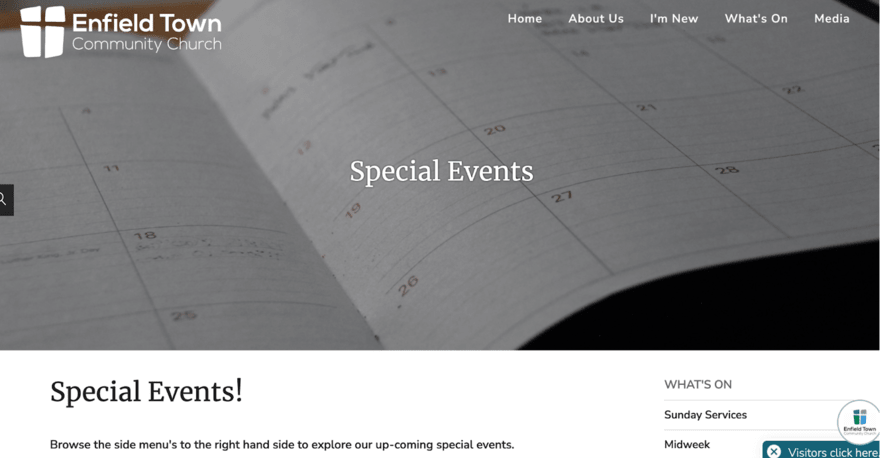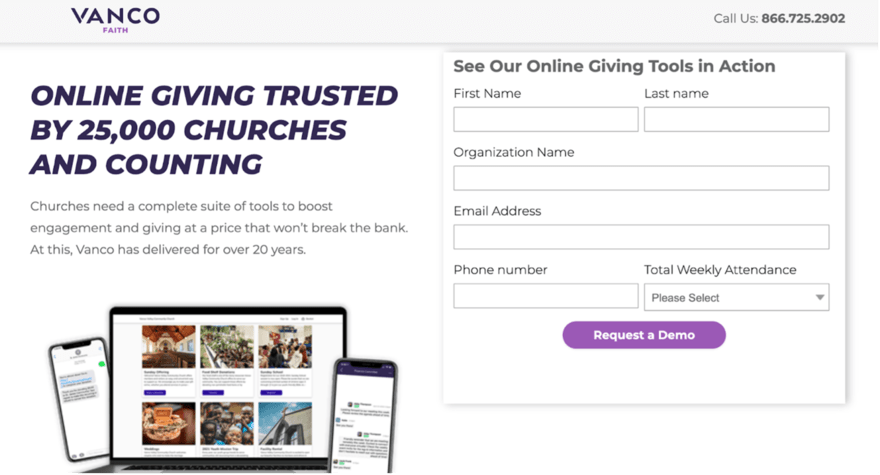Empowering Church Growth: 12 Church Marketing Strategies for 2024
If you click to purchase a product or service based on our independent recommendations and impartial reviews, we may receive a commission. Learn more
Churches have welcomed communities for generations, acting as a safe and reflective space for all. But in this increasingly online world, how do you grow your congregation and keep the feet flowing through your doors? You may have used a church website builder to create your online footprint, but that’s just the start. To be truly effective, you need to craft a compelling marketing strategy that’s going to get your church’s name out there and into the ears of the right people. Attracting new members requires innovative approaches to attract online users and turn them into long-term congregants.
But what marketing strategies should you be employing? Don’t worry – we’ve got your back. Here, we look at 12 watertight marketing strategies to empower your church’s growth online with a few handy offline tips thrown in for good measure.
Embrace the Digital Landscape
As the old saying goes, if you can’t beat them, join them! To achieve success with your church marketing strategy, it’s important to make use of all the digital marketing methods at your fingertips. Below, we’ll go through a few steps you can take to make sure your church is ticking all the right digital boxes.
#1 Craft a Compelling Church Website

If you don’t have a good website already, now’s the time to build one. To be competitive, churches need a solid web presence that goes beyond simply listing logistics. Your site design should focus on drawing visitors in and getting them engaged with church life.
For starters, make it super easy to find info – have menus leading to pages with service scheduling, events, and staff contacts. If someone wants to know where or when you meet, it should just take a click or two. Embed calendars so people know what’s coming up. The main goal is to help visitors feel informed.
Additionally, tighten up your SEO (search engine optimization) and use keywords in your content so that people can actually find your site through search engines when hunting for local churches on Google and even Bing. Tools like Semrush and Ahrefs help find the right keywords.
But it’s not enough to just inform. Include prominent and natural-sounding calls-to-action like “Come As You Are” or “Get Involved!” to encourage that next step into participation. Use them across the site and in blog posts that educate and engage readers.
Think of your website as a way to build community beyond your walls. Meeting people in their digital space allows you to then invite them into the joy of what you do in real life. It’s about channeling that welcoming spirit online. Take time over your website design, keep the info flowing, and give motivating nudges towards taking part in your mission. Do that, and your community will surely grow.
#2 Establish a Strong Social Media Presence

Reaching modern communities means stepping into popular online spaces, and there’s no better place for that than social media. First, identify where your target audiences actively hang out online – whether on Facebook, Instagram or elsewhere – and then craft your social media strategy.
Develop a consistent, friendly brand voice that communicates your genuine care while sharing inspiring content from events and messages to pique interest. Be sure to promptly respond to follower comments and questions too, as this helps build emotional bonds.
The plan is to meet people where they already virtually mingle, extending the same sincere welcome online as you would during in-person encounters. After all, the church is all about bringing more sheep into the caring flock.
#3 Leverage Online Video Streaming Platforms
Video content presents a powerful way for churches to broadcast messages and bolster community engagement. Create a strong video marketing strategy and leverage platforms like Facebook Live, and Vimeo to stream services, sermons, and events in real time. You can even create a church YouTube channel to share videos too!
Produce compelling video stories that put the impact of your church’s ministry on full display for people to witness and take part in. Showcase service opportunities through video, such as outreach programs, youth group activities, or special events, and holiday services.

Then promote your video links across social media platforms via shareable posts as well as links in profiles and websites. Quality, inspiring video content packaged and promoted effectively provides unlimited potential to increase your reach and visibility while strengthening connections with both existing members and prospective new attendees.
More information: If you’re using video in your overall marketing strategy, you must follow best practices when it comes to video SEO
#4 Implement Email Marketing Campaigns
Email marketing enables churches to extend personalized outreach straight to people’s inboxes. Build your list by capturing email addresses from visitors and existing members, then segment into groups like “Prospective Attendees” and “Regular Members” for targeted communications catered to their needs.
Promote signup links online in blog posts and at events to grow your list. Craft captivating subject lines that compel people to open. For example, you might want to use something along the lines of “Transform Lives – Starting with Yours”. The goal is to intrigue recipients.
When they open the email, you’ll also need tip-top content. Share church news and event updates, spotlight volunteer opportunities, provide digital spiritual guidance, and invite participation in ministries.
Well-executed email campaigns allow relationship-building on an individual basis, nurturing followers with customized messaging that inspires engagement with your community.
More Information: Make sure you’re well prepared to begin your email marketing journey by brushing up on email marketing best practices.
Fostering Community Connections
Church means community – one body united in pursuing faith. Now let’s explore technologies for fostering an even wider circle of spiritual belonging beyond physical walls.
#5 Host Community Events and Outreach Programs

Hosting inclusive community events provides churches with an avenue to cast a wider net for engagement and realize their mission of service. Brainstorm program ideas that would appeal not just to members but surrounding demographics too – think concerts, job fairs, and health seminars to name a few.
Join forces with respected local organizations to plan and promote events that broader audiences would gravitate towards. This is a good chance to loop your social media accounts in, too, using them amplify your church activities.
It’s important not to neglect opportunities outside of the digital world, though. You an still pass out engaging flyers and secure local radio and newspaper promotions to help boost visibility.
Well-promoted events that fill community needs help build invaluable exposure and goodwill. The more creative and collaborative the event, the more lives you impact and the more likely people will visit your church.
#6 Cultivate Partnerships with Local Businesses
Your church can amplify its outreach and engagement by collaborating with like-minded local businesses. Seek out respected establishments in town that already share significant follower overlap or similar values with your worship community.
Initial partnership opportunities worth exploring include co-hosting special events together to tap into combined audiences, cross-promoting happenings and services through shared networks, and providing discounts to each other’s members and customers.
Expect continuous positive exposure to new audiences to increase as the partnerships blossom over time through repeated cooperative initiatives. This will ultimately enable both your church and partners to better realize outreach goals and more richly serve the community at large.
#7 Empower Active Participation from Church Members

A church’s greatest asset is its people. Encouraging active participation from invested members can strengthen community ties and fuel growth. To achieve this, spotlight member stories on your website and in monthly newsletters to create a welcoming vibe.
Mobilize volunteers for outreach programs and special events through signups and reminders, and provide opportunities for talented members to showcase their gifts. This could involve leading musical worship, organizing ministries for personal passions like youth mentorship or homelessness aid, or even guest preaching sermon series.
Encourage increased participation to make community service commitments known. When members feel empowered to share their gifts and talents in service, you harness the collective passion that realizes the church’s highest good.
#8 Utilize Social Media to Amplify Community Engagement

Amplifying a sense of genuine community on social media can shape church participation both online and off. Curate shareable member stories that broadcast the meaning, belonging, and growth people experience in your ministry. This could be how someone’s life changed since joining the church or behind-the-scenes-content showcasing everyday happenings within the church.
Another helpful move is to promote community service initiatives, events, and activation opportunities across social platforms through attention-grabbing graphics and captions. Ask faithful attendees, volunteers and those serving in leadership roles to actively share, comment on, and forward church content to their personal networks.
When church members become digital evangelists, the result is often sustained social media buzz and visibility. Use shared community stories to increase local awareness and encourage more people to join and enrich your church.
Embracing Technology for Enhanced Communication
Although some people see the digital world as a barrier to human communication, it brings so many opportunities to enhance this element of our lives. Below, we explore how you can use digital strategies to build a connection online with souls seeking spiritual guidance.
#9 Implement a Church Management Software System
Managing all the programs, people, and operations in a modern church environment can get complex pretty quick. That’s why more and more houses of worship now use centralized management software to help coordinate things.
There’s no need to reinvent the wheel when it comes to this – there are some great tailored solutions out there specifically built to help faith organizations run more efficiently. Popular options include Planning Center, Church Windows, and Tithe.ly.
The key is finding a platform that brings all your major admin tasks into one place. Think things like:
- Member databases
- Email newsletters
- Event promotion
- Online donations
- Attendance tracking
These elements of running a church used to require a bunch of manual effort or separate tools. Now, however, they can be automated and streamlined. This saves staff and volunteers tons of time while reducing human error.
The right management software, customized for a church’s needs, basically helps remove the friction from operations and engagement so more energy goes towards community building and spreading the mission.
When historical data, schedules, and member info are a click away, you can focus on faithfully serving people with those extra resources available. Consider bringing your systems up to speed and discover how much easier spreading light and love can flow with the right support behind the scenes.
#10 Facilitate Convenient and Secure Donations with Online Giving Platforms
No matter where you’re based, churches are always in need of extra financial support. That’s why smart churches deploy secure online giving platforms for donations integrated with their website and mobile apps. Providing diverse payment options makes donating effortless for members on the go.
Of course, you still want to maintain that intimate feel of personally investing in your spiritual home, so be sure to highlight testimonies of how specific gifts make an impact. Stay transparent with financial updates too. Try to foster trust and excitement around giving.

It’s equally important that the technology safeguards sensitive data. Do your homework to implement reliable solutions that keep transactions protected behind encryption, authentication, compliance with data protection regulations, and regular security audits and updates.
Handle it right, and watch contributions grow. Enable people to donate from their couch or phone knowing their information and intentions are handled with care.
#11 Develop a Mobile App for Easy Access and Engagement
Having a custom church app that integrates into people’s smartphones just makes practical sense in a world where more than 50% of people access the internet on a mobile device. It puts valuable community resources right in their pockets.
Focus first on providing an intuitive interface that makes the key info easy to access. This includes elements like service times, past sermon archives, and volunteer opportunities. Build the app to offer true convenience.
Then look at how to keep it top of mind so it becomes a go-to spiritual resource. Push notifications are great for this and you can send users inspiring quotes, remind them of events coming up, and even put out volunteer requests. Ask members for feedback, seeing what they would like to see from the service.
And don’t forget the power of on-the-spot functions that meet real-time needs, from donations to event signups and prayer request submissions. This will help to streamline engagement.
At its heart, developing a specific church app is about enhancing your ministry’s ability to guide and connect on a 24/7 basis wherever people are at digitally.
#12 Explore Immersive Experiences with Virtual Reality (VR) and Augmented Reality (AR)
What if the streets of ancient Jerusalem sprung up right in your youth lounge? Or if teens could view scenes from the Bible, walking the roads with disciples? Okay, so technology might not be this far along just yet, but it’s entirely possible to have such immersive experiences in the future.
In the meantime, virtual reality and augmented reality can create engaging and interactive experiences through virtual church tours, immersive Bible stories, and interactive faith-based educational content.
Take church tours. It’s a great way for potential members to get an idea for the look and feel of a church before visiting in person. This can be particularly helpful if someone is moving to the area but wants a sneak peek first.
This type of tech is also helpful for special events and outreach programs, where concerts, talks, or workshops allow broader participation from people who are geographically distant.
Interactive tools like these can nurture curiosity and understanding while adding a whole new dynamic to your church.
Summary: 12 Church Marketing Strategies
As culture continues evolving, so must ministry marketing. Through implementing the strategies discussed above and adapting them as the needs of your local community change, you can magnify your messages of faith and capture the attention of those looking to join a church.
From developing a social media presence to integrating on-demand video resources on your website, you can ensure that your church has a dynamic setup that beats out the competition and welcomes modern-day worshipers through its doors.

Leave a comment